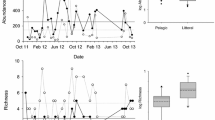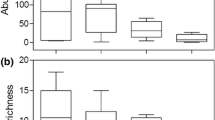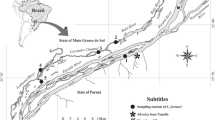Abstract
The dynamics of populations of short-lived organisms are very patchy, both in space and time. The production of dormant propagules, however, results in an effective increase in generation time. We hypothesize that prolonged dormancy, together with variable regeneration niches, result in integration of temporal variability in community structure. In addition, in aquatic habitats, mechanisms such as sediment focussing can contribute to the integration of spatial variability. We tested the hypothesis that dormant propagule banks integrate spatial and temporal variation in active zooplankton communities. This was done by comparing cladoceran species richness and the community structure of hatchling assemblages retrieved from propagule bank samples collected on a single occasion with assemblages encountered in active community samples covering spatial variation (littoral and pelagic zone), diel (day and night), intra-year (May–October) and inter-year variation (1996–2000). The egg bank community structure differed significantly from the active community structure, but the dissimilarity decreased as spatial and temporal variation was better covered by the active community samples. Furthermore, the identification of all fully grown hatchlings (n=214) yielded an equally high number of species (n=22) to that occurring in all active community samples together (a total of 1,730 individuals were analysed). We conclude that the analysis of dormant propagules may form a cost-efficient alternative tool to the analysis of active community samples for an integrated assessment of cladoceran communities.


Similar content being viewed by others
References
Anderson NJ, Battarbee, RW (1994) Aquatic community persistence and variability: a palaeoecological perspective. In: Giller PS, Hildrew AG, Raffaelli D (eds) Aquatic ecology: scale, pattern and processes. Blackwell Scientific Publications, London, pp 233–259
Arnott SE, Magnuson JJ, Yan ND (1998) Crustacean zooplankton species richness: single- and multiple-year estimates. Can J Fish Aquat Sci 55:1573–1582
Arnott SE, Yan ND, Magnuson JJ, Frost TM (1999) Interannual variability and species turnover of crustacean zooplankton in Shield lakes. Can J Fish Aquat Sci 56:162–172
Battarbee RW (2000) Palaeolimnological approaches to climate change, with special regard to the biological record. Quat Sci Rev 19:107–124
Baur B, Joshi J, Schmid B, Hanggi A, Borcard D, Stary J, Pedrolichristen A, Thommen GH, Luka H, Rusterholz HP, Oggier P, Ledergerber S, Erhardt A (1996) Variation in species richness of plants and diverse groups of invertebrates in three calcareous grasslands of the Swiss Jura mountains. Rev Suisse Zool 103:801–833
Brendonck L, De Meester L (2003) Egg banks in freshwater zooplankton: evolutionary and ecological archives in the sediment. In: Van Donk E, Spaak P, Boersma M (eds) Recent developments in fundamental and applied plankton research. Hydrobiologia 491:65–84
Burks RL, Lodge DM, Jeppesen E, Lauridsen TL (2002) Diel horizontal migration of zooplankton: costs and benefits of inhabiting the littoral. Freshw Biol 47:343–365
Cáceres CE (1997) Temporal variation, dormancy, and coexistence: a field test of the storage effect. Proc Natl Acad Sci U S A 94:9171–9175
Cáceres CE (1998) Interspecific variation in the abundance, production, and emergence of Daphnia diapausing eggs. Ecology 79:1699–1710
Cáceres CE, Hairston NG Jr (1998) Benthic-pelagic coupling in planktonic crustaceans: the role of the benthos. Arch Hydrobiol Spec Issues Adv Limnol 52:163–174
Carvalho GR, Crisp DJ (1987) The clonal ecology of Daphnia magna (Crustacea: Cladocera). I. Temporal changes in the clonal structure of a natural population. J Anim Ecol 56:453–468
Chesson PL (1983) Coexistence of competitors in a stochastic environment: the storage effect. In: Freeman HI, Strobeck C (eds) Population biology. Lecture notes in biomathematics. Springer, Berlin Heidelberg New York 77:188–198
Clarke KR, Warwick RM (1994) Change in marine communities: an approach to statistical analysis and interpretation. Plymouth Marine Laboratory, Plymouth, p 144
Cohen D (1966) Optimizing reproduction in a randomly varying environment. J Theor Biol 12:119–129
Colwell RK (1997) EstimateS: statistical estimation of species richness and shared species from samples. Version 5. User’s Guide and application. http://viceroy.eeb.uconn.edu/estimates
Cottenie K, De Meester L (2004) Metacommunity structure: synergy of biotic interactions as selective agents and dispersal as fuel. Ecology 85:114–119
Cousyn C, De Meester L, Colbourne JK, Brendonck L, Verschuren D, Volckaert F (2001) Rapid, local adaptation of zooplankton behavior to changes in predation pressure in the absence of neutral genetic changes. Proc Natl Acad Sci U S A 98:6256–6260
Crispim MC, Watanabe T (2001) What can dry reservoir sediments in a semi-arid region in Brazil tell us about cladocera? Hydrobiologia 442:101–105
De Meester L, Dawidowicz P, van Gool E, Loose CJ (1999). Ecology and evolution of predator-induced behavior of zooplankton: depth selection behavior and diel vertical migration. In: Tollrian R, Harvell CD (eds) The ecology and evolution of inducible defenses. Princeton University Press, Princeton
De Stasio BT Jr (1993) Diel vertical migration by zooplankton: population budgets and the diurnal deficit. Bull Mar Sci 53:44–64
Duggan IC, Green JD, Shiel RJ (2002) Rotifer resting egg densities in lakes of different trophic state, and their assessment using emergence and egg counts. Arch Hydrobiol 153:409–420
Ellner SP, Hairston NG Jr (1994) Role of overlapping generations in maintaining genetic variation in a fluctuating environment. Am Nat 143:403–417
Ellner SP, Hairston NG Jr, Babaï D (1998) Long-term diapause and spreading of risk across the life cycle. Arch Hydrobiol Spec Issues Adv Limnol 52:297–312
Flößner D (2000) Die Haplopoda und Cladocera (ohne Bosminidae) Mitteleuropas. Backhuys Publishers, Leiden, p 428
Freeland JR, Rimmer VK, Okamura B (2001) Genetic changes within freshwater bryozoan populations suggest temporal gene flow from statoblast banks. Limnol Oceanogr 46:1121–1129
Fryer G (1996) Diapause, a potent force in the evolution of freshwater crustaceans. Hydrobiologia 320:1–14
Geertsema W, Sprangers JTCM (2002) Plant distribution patterns related to species characteristics and spatial and temporal habitat heterogeneity in a network of ditch banks. Plant Ecol 162:91–108
Gómez A, Carvalho GR (2000) Sex, parthenogenesis and the genetic structure of rotifers: microsatellite analysis of contemporary and resting egg bank populations. Mol Ecol 9:203–214
Gómez A, Adcock GJ, Lunt DH, Carvalho GR (2002) The interplay between colonisation history and gene flow in passively dispersing zooplankton: microsatellite analysis of rotifer resting egg banks. J Evol Biol 15:158–171
Grover JP (1999) Water fleas on cycles. Nature 402:592–593
Hairston NG Jr (1996) Zooplankton egg banks as biotic reservoirs in changing environments. Limnol Oceanogr 41:1087–1092
Hairston NG Jr, Cáceres CE (1996) Distribution of crustacean diapause: micro- and macroevolutionary pattern and process. Hydrobiologia 320:27–44
Hairston NG Jr, De Stasio BT (1988) Rate of evolution slowed by dormant propagule pool. Nature 336:239–242
Havel JE, Eisenbacher EM, Black AA (2000) Diversity of crustacean zooplankton in riparian wetlands: colonization and egg banks. Aquat Ecol 34:63–76
Jankowski T, Straile D (2003) A comparison of egg-bank and long-term plankton dynamics of two Daphnia species, D. hyalina and D. galeata: potentials and limits of reconstruction. Limnol Oceanogr 48:1948–1955
Jeppesen E, Søndergaard M, Søndergaard M, Christoffersen K (eds) (1997) The structuring role of submerged macrophytes in lakes. Ecological studies 131. Springer, Berlin Heidelberg New York, p 423
Jeppesen E, Leavitt P, De Meester L, Jensen JP (2001) Functional ecology and palaeolimnology: using cladoceran remains to reconstruct anthropogenic impact. Trends Ecol Evol 16:191–198
Kluttgen B, Dulmer U, Engels M, Ratte HT (1994) ADAM, an artificial fresh-water for the culture of zooplankton. Water Res 28:743–746
Lauridsen TL, Lodge DM (1996) Avoidance by Daphnia magna of fish and macrophytes: chemical cues and predator-mediated use of macrophyte habitat. Limnol Oceanogr 41:794–798
Leibold MA (1996) A graphical model of keystone predators in food webs: trophic regulation of abundance, incidence, and diversity patterns in communities. Am Nat 147:784–812
Marcus NH (1990) Calanoid copepod, cladoceran, and rotifer eggs in sea-bottom sediments of northern Californian coastal waters: identification, occurrence and hatching. Mar Biol 105:413–418
May L (1986) Rotifer sampling—a complete species list from one visit. Hydrobiologia 134:117–120
Onbé T (1978) Sugar flotation method for the sorting the resting eggs of marine cladocerans and copepods from sea-bottom sediment. Bull Jpn Soc Sci Fish 44:1411
Ortells R, Snell TW, Gómez A, Serra M (2000) Patterns of genetic differentiation in resting egg banks of a rotifer species complex in Spain. Arch Hydrobiol 149:529–551
Philippi T, Seger J (1989) Hedging one’s evolutionary bets, revisited. Trends Ecol Evol 4:41–44
Pinnel-Alloul B (1995) Spatial heterogeneity as a multiscale characteristic of zooplankton community. Hydrobiologia 301:17–42
Sasaki A, Ellner SP (1995) The evolutionarily stable phenotype distribution in a random environment. Evolution 49:337–350
Scheffer M (1998) Ecology of shallow lakes. Chapman and Hall, London, p 357
Schroll H (2002) Indicators of the long-term eutrophication of a Danish lake (Karlso), and water pollution management. J Transdiscipl Environ Studies 1:1–10
Silvertown J, McConway KL, Hughes Z, Biss P, Macnair M, Lutman P (2002) Ecological and genetic correlates of long-term population trends in the park grass experiment. Am Nat 160:409–420
Sommer U, Gliwicz ZM, Lampert W, Duncan A (1986) The PEG-model of seasonal succession of planktonic events in fresh waters. Arch Hydrobiol 106:433–471
Statsoft Inc (2003) Electronic statistics textbook. OK: Statsoft, Tulsa. http://www.statsoft.com/textbook/stathome.html
Vinson MR, Hawkins CP (1998) Biodiversity of stream insects: variation at local, basin, and regional scales. Annu Rev Entomol 43:271–293
Weider LJ, Lampert W, Wessels M, Colbourne JK, Limburg P (1997) Long-term genetic shifts in a microcrustacean egg bank associated with anthropogenic changes in the Lake Constance ecosystem. Proc R Soc Lond B Biol Sci 264:1613–1618
Wetzel R, Likens G (2000) Limnological Analysis, 3rd edn. Springer, Berlin Heidelberg New York
Wiles L, Schweizer E (2002) Spatial dependence of weed seed banks and strategies for sampling. Weed Sci 50:595–606
Acknowledgements
We thank Natuurpunt v.z.w., and especially warden Willy Peumans, for giving us access to the nature reserve De Maten and for their co-operation. We thank the many people who helped during the sampling campaign, especially Karl Cottenie and Eddy Holsters. We are grateful to Joost Raeymakers for help with statistical analysis. This study was supported by the EU-funded project BIOMAN (Biomanipulation and Human Impact in Shallow Lakes, EVK2-CT-1999-00046) and by the Danish Natural Science Research Council research project “Consequences of weather and climate changes for marine and freshwater ecosystems. Conceptual and operational forecasting of the aquatic environment” (CONWOY).
Author information
Authors and Affiliations
Corresponding author
Additional information
An erratum to this article is available at http://dx.doi.org/10.1007/s00442-005-0020-9.
Rights and permissions
About this article
Cite this article
Vandekerkhove, J., Declerck, S., Jeppesen, E. et al. Dormant propagule banks integrate spatio-temporal heterogeneity in cladoceran communities. Oecologia 142, 109–116 (2005). https://doi.org/10.1007/s00442-004-1711-3
Received:
Accepted:
Published:
Issue Date:
DOI: https://doi.org/10.1007/s00442-004-1711-3




